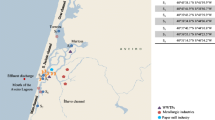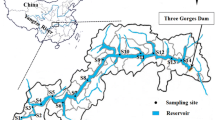Abstract
Recent studies in the Douro River estuary show signs of pollution in the area and of fish endocrine disruption. However, the chemical nature of the local contamination has not been fully investigated nor have studies checking for the simultaneous presence of endocrine-disrupting chemicals (EDCs), either of animal (estrone, E1; estradiol, E2), pharmaceutical (17α-ethynylestradiol, EE2), vegetal (daidzein, DAID; genistein, GEN; biochanin A, BIO-A), or industrial (bisphenol A, BPA; 4–octylphenol, 4-OP; 4-nonylphenol, 4-NP) origins. Thus, the main objective of this study was to examine the presence of these EDCs in estuarine water samples collected, in every season of the year, at nine sampling stations along the estuarine gradient. All samples were processed by two-step solid-phase extraction (Oasis HLB followed by silica) prior to high-performance liquid chromatography with diode-array detection (HPLC-DAD) and gas chromatography–mass spectrometry (GC-MS) analyses. The current data showed that E1 and EE2, all phytoestrogens, and BPA were identified and measured in this estuary. In contrast, 4-OP was only detected by GC-MS and E2 and 4-NP were not found. Additionally, E1 (up to 112.9 ng/L) and EE2 (up to 101.9 ng/L) were both measured in biologically hazardous amounts in winter. In the year sampled, the phytoestrogens suggested a possible seasonal pattern of fluctuation. Both DAID (up to 888.4 ng/L) and GEN (183.6 ng/L) were maximal in early summer, whereas BIO-A (up to 191.4 ng/L) reached its highest concentrations in winter. BPA (up to 10.7 μg/L) also attained highest levels in winter. In December 2005, it is hypothesized that E1, EE2, and BPA concentrations were atypically high due to current drought conditions. Almost all assayed EDCs existed in all seasons and, therefore, might have contributed to endocrine disruption of aquatic animals, previously documented by the high rate of ovotestis in fish caught in this estuary.




Similar content being viewed by others
References
Almeida C, Serôdio P, Florêncio MH, Nogueira JMF (2007) New strategies to screen for endocrine-disrupting chemicals in the Portuguese marine environment utilizing large volume injection-capillary gas chromatography-mass spectrometry combined with retention time locking libraries (LVI-GC-MS-RTL). Anal Bioanal Chem 387:2569–2583
Azevedo DA, Lacorte S, Viana P, Barceló D (2001) Analysis of priority pesticides and phenols in Portuguese river water by liquid chromatography-mass spectrometry. Chromatographia 53:113–118
Ballesteros O, Zafra A, Navalon A, Vilchez JL (2006) Sensitive gas chromatographic-mass spectrometric method for the determination of phthalate esters, alkylphenols, bisphenol A and their chlorinated derivatives in wastewater samples. J. Chromatogr A 1121:154–162
Belfroid AC, Van der Horst A, Vethaak AD et al (1999) Analysis and occurrence of estrogenic hormones and their glucuronides in surface water and waste water in The Netherlands. Sci Total Environ 225:101–108
Benassayag C, Perrot-Applanat M, Ferre F (2002) Phytoestrogens as modulators of steroid action in target cells. J Chromatogr B 777:233–248
Booth NL, Overk CR, Yao P et al (2006) Seasonal variation of red clover (Trifolium pratense L., Fabaceae) isoflavones and estrogenic activity. J Agric Food Chem 54:1277–1282
Bordalo AA, Teixeira R, Wiebe WJ (2006) A water quality index applied to an international shared river basin: the case of the Douro river. Environ Manage 38:910–920
Bordalo AA, Vieira MEC (2005) Spatial variability of phytoplankton, bacteria and viruses in the mesotidal salt wedge Douro Estuary (Portugal). Est Coast Shelf Sci 63:143–154
Cararmelo L, Orgaz MDM (2007) A study of precipitation variability in the Duero Basin (Iberian Peninsula). Int J Climatol 27:327–339
Cespedes R, Lacorte S, Raldua D, Ginebreda A, Barceló D, Pina B (2005) Distribution of endocrine disruptors in the Llobregat River basin (Catalonia, NE Spain). Chemosphere 61:1710–1719
Ellis J, Kanamori S, Laird PG (1977) Water pollution studies on Lake Illawarra. I. Salinity variations and estimation of residence time. Marine Freshwater Res 28:467–477
Ferreira M, Antunes P, Gil O, Vale C, Silva L, Reis-Henriques MA (2002) Testis-ova in mullet (Mugil cephalus) exposed to organic contaminants in the Douro Estuary, Portugal. In: Proceedings of the 21th conference of European comparative endocrinologists, Germany
Ferreira M, Moradas-Ferreira P, Reis-Henriques MA (2006) The effect of long-term depuration on phase I and phase II biotransformation in mullets (Mugil cephalus) chronically exposed to pollutants in River Douro estuary, Portugal. Marine Environ Res 61:326–338
Gutendorf B, Westendorf J (2001) Comparison of an array of in vitro assays for the assessment of the estrogenic potential of natural and synthetic estrogens, phytoestrogens and xenoestrogens. Toxicology 166:79–89
International Conference on Harmonisation (ICH) (1996) Validation of analytical procedures: methodology, Q2B (CPMP/ICH/281/96)
Johnson AC, Belfroid A, Di Corcia A (2000) Estimating steroid oestrogen inputs into activated sludge treatment works and observations on their removal from the effluent. Sci Total Environ 256:163–173
Kiparissis Y, Balch GC, Metcalfe TL , Metcalfe CD (2003) Effects of the isoflavones genistein and equol on the gonadal development of Japanese medaka (Oryzias latipes). Environ Health Perspect 111:1158–1163
Komori K, Tanaka H, Okayasu Y, Yasojima M , Sato C (2004) Analysis and occurrence of estrogen in wastewater in Japan. Water Sci Technol 50:93–100
Lagana A, Bacaloni A, De Leva I, Faberi A, Fago G, Marino A (2004) Analytical methodologies for determining the occurence of endocrine disrupting chemicals in sewage treatment plants and natural waters. Anal Chim Acta 501:79–88
Lee SH, Jung BH, Kim SY, Chung BC (2004) Determination of phytoestrogens in traditional medicinal herbs using gas chromatography-mass spectrometry. J Nutr Biochem 15:452–460
Liggins J, Bluck LJC, Runswick S, Atkinson C, Coward WA, Bingham SA (2000a) Daidzein and genistein content of fruits and nuts. J Nutr Biochem 11:326–331
Liggins J, Bluck LJC, Runswick S, Atkinson C, Coward WA, Bingham SA (2000b) Daidzein and genistein contents of vegetables. Br J Nutr 84:717–725
Liggins J, Mulligan A, Runswick S, Bingham SA (2002) Daidzein and genistein content of cereals. Eur J Clin Nutr 56:961–966
Lintelmann J, Katayama A, Kurihara N, Shore L, Wenzel A (2003) Endocrine disruptors in the environment (IUPAC Technical Report). Pure Appl Chem 75:631–681
Metcalfe CD, Metcalfe TL, Kiparissis Y et al (2001) Estrogenic potency of chemicals detected in sewage treatment plant effluents as determined by in vivo assays with Japanese medaka (Oryzias latipes). Environ Toxicol Chem 20:297–308
Mills LJ, Chichester C (2005) Review of evidence: are endocrine-disrupting chemicals in the aquatic environment impacting fish populations? Sci Total Environ 343:1–34
Mucha AP, Bordalo AA, Vasconcelos M (2004) Sediment quality in the Douro river estuary based on trace metal contents, macrobenthic community and elutriate sediment toxicity test (ESTT). J Environ Monit 6:585–592
Noppe H, Verslycke T, De Wulf E et al (2007) Occurrence of estrogens in the Scheldt estuary: a 2-year survey. Ecotoxicol Environ Safety 66:1–8
Quiros L, Cespedes R, Lacorte S et al (2005) Detection and evaluation of endocrine-disruption activity in water samples from Portuguese rivers. Environ Toxicol Chem 24:389–395
Ramalhosa E, Pereira E, Vale C, Valega M, Monterroso P, Duarte AC (2005) Mercury distribution in Douro estuary (Portugal). Marine Pollut Bull 50:1218–1222
Ribeiro C, Tiritan ME, Rocha E, Rocha MJ (2007) Development and validation of a HPLC-DAD method for determination of several endocrine disrupting compounds in estuarine water. J Liq Chromatogr Relat Technol 30:2729–2746
Segner H, Navas JM, Schafers C, Wenzel A (2003) Potencies of estrogenic compounds in in vitro screening assays and in life cycle tests with zebrafish in vivo. Ecotoxicol Environ Safety 54:315–322
Shareef A, Angove MJ, Wells JD (2006) Optimization of silylation using N-methyl-N-(trimethylsilyl)-trifluoroacetamide, N,O-bis-(trimethyl.silyl)-trifluoroacetamide and N-(tert-butyldimethylsilyl)-N-methyltrifluoroacetamide for the determination of the estrogens estrone and 17 alpha-ethinylestradiol by gas chromatography-mass spectrometry. J Chromatogr A 1108:121–128
Silveira M (2007) Identification of endocrine disruptors in superficial waters of Douro River estuary, University of Porto, Portugal
Staples CA, Woodburn K, Caspers N, Hall AT, Klecka GM (2002) A weight of evidence approach to the aquatic hazard assessment of bisphenol A. Hum Ecol Risk Assess 8:1083–1105
Vasconcelos RP, Reis-Santos P, Fonseca V et al (2007) Assessing anthropogenic pressures on estuarine fish nurseries along the Portuguese coast: a multi-metric index and conceptual approach. Sci Total Environ 374:199–215
Vethaak AD, Lahr J, Schrap SM et al (2005) An integrated assessment of estrogenic contamination and biological effects in the aquatic environment of The Netherlands. Chemosphere 59:511–524
Vieira MEC, Bordalo AA (2000) The Douro estuary (Portugal): a mesotidal salt wedge. Oceanol Acta 23:585–594
Waring RH, Harris RM (2005) Endocrine disrupters: a human risk? Mol Cell Endocrinol 244:2–9
Acknowledgments
This study was financially supported by the Fundação para a Ciência e Tecnologia (FCT; PhD Grant SFRH/BD/18231/2004/SLU, attributed to Cláudia Ribeiro) and by the Cooperativa de Ensino Superior, Politécnico e Universitário, CRL (CESPU)/ISCS-N (Research Projects 1F/13/2005/CESPU and 2F/02/2006/CESPU).
Author information
Authors and Affiliations
Corresponding author
Rights and permissions
About this article
Cite this article
Ribeiro, C., Tiritan, M.E., Rocha, E. et al. Seasonal and Spatial Distribution of Several Endocrine-Disrupting Compounds in the Douro River Estuary, Portugal. Arch Environ Contam Toxicol 56, 1–11 (2009). https://doi.org/10.1007/s00244-008-9158-x
Received:
Accepted:
Published:
Issue Date:
DOI: https://doi.org/10.1007/s00244-008-9158-x




